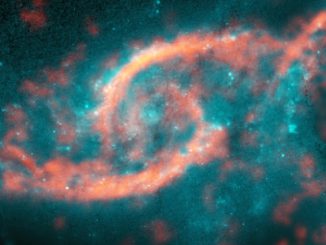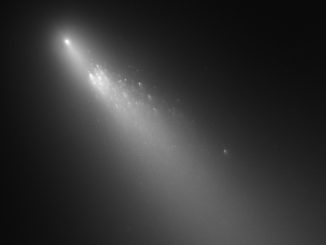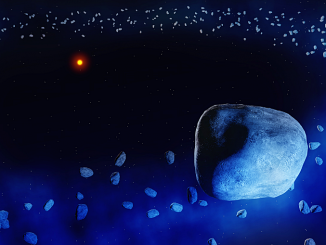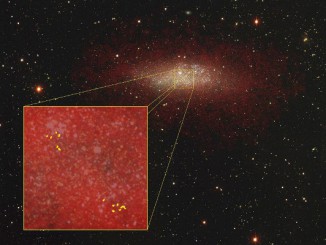
carbon monoxide


A stellar circle of life near Cygnus X-3
A discovery that provides a new way to study how stars form has been captured in a new portrait from NASA’s Chandra X-ray Observatory and the Smithsonian’s Submillimetre Array (SMA). A cloud that is giving birth to stars has been observed to reflect X-rays from Cygnus X-3, a source of X-rays produced by a system where a massive star is slowly being eaten by its companion black hole or neutron star.

Interacting galaxies produce eye-shaped “tsunami” of stars
Astronomers using the Atacama Large Millimetre/submillimetre Array (ALMA) have discovered a tsunami of stars and gas that is crashing midway through the disc of a spiral galaxy known as IC 2163. This colossal wave of material — which was triggered when IC 2163 recently sideswiped another spiral galaxy dubbed NGC 2207 — produced dazzling arcs of intense star formation that resemble a pair of eyelids.

Relationship revealed between chemicals found on comets
A new study reveals similarities and relationships between certain types of chemicals found on 30 different comets, which vary widely in their overall composition compared to one another. The research is part of ongoing investigations into these primordial bodies, which contain material largely unchanged from the solar system’s birth some 4.6 billion years ago.

ALMA uncovers insights into “Golden Age” of galaxy formation
International teams of astronomers have used the Atacama Large Millimeter/submillimeter Array (ALMA) to explore the distant corner of the universe first revealed in the iconic images of the Hubble Ultra Deep Field (HUDF). These new ALMA observations are significantly deeper and sharper than previous surveys at millimetre wavelengths.


Surprising discovery of molecular oxygen on comet 67P
ESA’s Rosetta spacecraft has made the first in situ detection of oxygen molecules outgassing from Comet 67P/Churyumov-Gerasimenko, a surprising observation that suggests they were incorporated into the comet during its formation. This may have implications for our understanding of the chemistry involved in the formation of the solar system some 4.6 billion years ago.

Happy Hour on Comet Lovejoy
Comet Lovejoy lived up to its name by releasing as much ethyl alcohol as in at least 500 bottles of wine every second as well as a type of sugar into space during its peak activity, according to new observations by an international team. The finding adds to the evidence that comets could have been a source of the complex organic molecules necessary for the emergence of life.

Peeking into our galaxy’s stellar nursery
Astronomers have long turned their telescopes to the wide swaths of interstellar medium to get a look at the formation and birth of stars. A team of international researchers has just released the most comprehensive images anyone has ever seen of the Milky Way’s cold interstellar gas clouds where new stars and solar systems are being born.

Dwarf galaxy WLM becomes star-forming powerhouse
Nearby dwarf galaxy Wolf—Lundmark—Melotte (WLM) poses an intriguing mystery: How is it able to form brilliant star clusters without the dusty, gas-rich environments found in larger galaxies? The answer, astronomers believe, lies in densely packed and previously unrecognised nuggets of star-forming material sprinkled throughout the galaxy.
